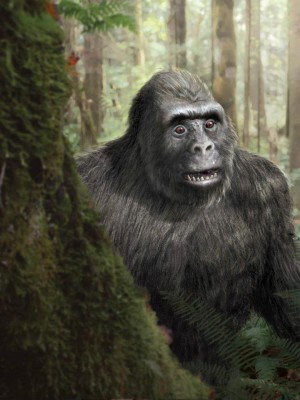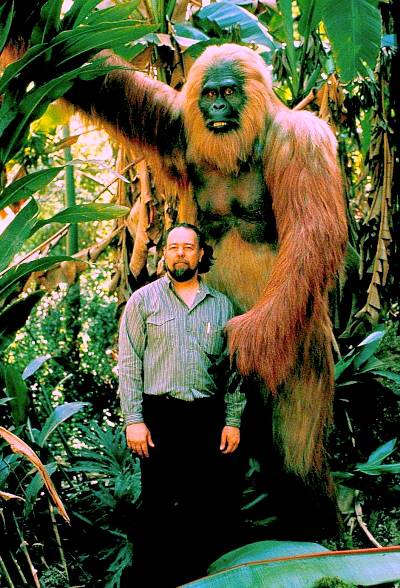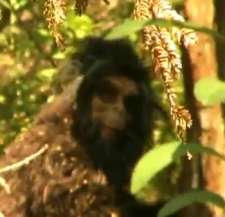by
Daniel Loxton, Feb 14 2013
The internet was buzzing yesterday with the long-anticipated1 release of a paper purporting to present DNA evidence that “conclusively proves that the Sasquatch exist as an extant hominin and are a direct maternal descendent of modern humans.”2 With DNA sourced, according to the paper, from among “One hundred eleven samples of blood, tissue, hair, and other types of specimens,” this is the most prominent Sasquatch DNA case to date.
Full expert review of the team’s data and methods should emerge in the coming days. In the meantime, science writers identified several serious red flags within hours of the paper’s release.
Continue reading…
comments (40)
by
Daniel Loxton, Jan 29 2013
Skepticblog’s Steven Novella has an interesting post up at Neurologica this morning, in which he addresses some issues of conflation between scientific skepticism and other movements or interests. Specifically, Novella discusses the very old (and demonstrably false) complaint that scientific skepticism refuses to “take on” religious claims, and the similarly perennial complaint that skeptics ought to get into the business of political claims.
On religion, he emphasizes once again the same point he has made throughout his career (a point on which I precisely agree, and which has for decades been the practical, time-tested, virtually universal position of scientific skepticism as a movement):
This one will simply not go away. No matter how many times I clarify and re-clarify my position on religion and skepticism the framing of the issue by those who think skepticism should address matters of faith does not change, which implies to me that they are not really listening. I know PZ is not specifically addressing me here, and there are true accommodationists out there (those who think religious thinking and scientific thinking are compatible and should be integrated), but since he is talking about prominent skeptics he should at least address what every prominent skeptic I know (Eugenie Scott, Massimo Pigliucci, Michael Shermer, Joe Nickell, and others) who shares my position has to say on this matter.
Here it is (again) – The issue is not with religion or religious-based claims. We address them all the time (creationism, miracles, faith healing, separation of church and state, secular moral philosophy, etc.) Really – we are right there shoulder to shoulder with organized atheists taking on every such issue. It is NOT that religious claims are untestable (some are, some aren’t), it is only that when claims (religious or otherwise) are framed as untestable then they are matters of faith and not science.
Continue reading…
comments (19)
by
Steven Novella, Nov 26 2012
The Bigfoot community (yes, they still exist) is abuzz with the announcement that Bigfoot/Sasquatch DNA has been analyzed with interesting results. Bigfoot is the alleged large North American furry hominid that roams the deep forest, largely in the Pacific Northwest. It is known only from sightings and ambiguous trace evidence (blurry photographs, footprints, hair samples), but is most famous from the Patterson-Gimlin film (touted by believers, but highly criticized by skeptics).
After decades, however, what we lack is a physical specimen. No one has captured a bigfoot, killed one, found a dead body or skeleton. There is also no fossil evidence supporting the existence of such a creature. Researchers have found biological samples (such as hair or skin) that they claimed were from a bigfoot. The big news today is that a five-year study to sequence and analyze DNA from these samples has now concluded. I predict that the results will be touted by believers but highly criticized by skeptics.
The results have not yet been peer-reviewed or published, so there will definitely need to to be follow up when this occurs. The work was headed by Dr. Melba Ketchum, a geneticist working in Texas. Apparently she was scooped by a Russian collaborator, Igor Butsev, who released the results on his Facebook page. Ketchum was then forced to put out a press release confirming the findings. The press release indicates:
Continue reading…
comments (64)
by
Daniel Loxton, Nov 13 2012
Recently Skeptical Inquirer writer Benjamin Radford posted a question to the Facebook Group thread for Skeptic magazine’s cryptozoology-themed podcast MonsterTalk on the topic of the infamous Patterson-Gimlin film (purported to show a sasquatch striding across a sandbar in the woods). What are we to make, Radford wondered, of claims that the film cannot be duplicated because it would be too expensive, too difficult technically—or perhaps even impossible to recreate due to the anatomical limits of human actors? I responded to say that all such arguments are in my opinion baloney, but that this does not necessarily imply that attempts to recreate the film to the satisfaction of fair viewers actually ever will succeed. Even if the original was a crude hoax accomplished by cheap, simple means (as I suspect) it may still be the case that it can never be matched.
The reason goes well beyond Patterson or Bigfoot or cryptozoology, and right to the heart of artistic creation. It’s a truth I learned in painting and photography, a truth I live with every day in my work as as a writer and illustrator: sometimes you just get lucky. Sometimes things just work. There’s no great reason for it, no secret key you can turn a second time. Sometimes lightning strikes—and then it is gone. As an artist you seize those moments of magic, knowing you cannot get them back.
Continue reading…
comments (9)
by
Donald Prothero, Jul 04 2012

Daniel Loxton’s new painting of Bigfoot, one of his many new illustrations for our upcoming cryptozoology book
As Daniel Loxton and I completed our upcoming book on cryptozoology, we tried to analyze and dissect the psychology of cryptozoology, and the followers of cryptids like Bigfoot. What motivates these people? Why do they think this way?
Writer Joshua Blu Buhs provided an interesting portrait of the Bigfoot community as typical of the amateur cryptozoologists. Studying the Bigfoot fans in the Pacific Northwest, Buhs documents a group of mostly white working-class men who are Bigfoot’s biggest boosters. To them, Bigfoot is an icon of untamed masculinity, a populist rebel against scientific elites, the last champion of authenticity against a plastic, image-conscious, effeminate consumer society. (Yet as a supreme irony, Bigfoot has a career as advertising mascot and tabloid fodder, making him a major purveyor of consumerism.) Buhs shows that many Bigfoot stalkers follow the subculture because it has the same attractions as other types of hunting: getting back to nature, tramping through the woods in search of elusive prey, testing their manhood against the wilderness, and play at being “real men”. He quotes Thom Powell, who says, “I think I became interested in the Bigfoot thing because it gave me an excuse to get out and use my wilderness skills. My live-long love of the wilderness exploration has a purpose beyond just getting there and back.” Contractor Tom Morris said, “Maybe I’m only trying to justify all my trips to the mountains by calling them research. I like wildlife, I like to see anything I can. The more I go, the more I’m amazed at how elusive wildlife can be. I’m happy just to be up there, watching the animals move around. I want to come back with the best pictures I can. The ultimate would be a shot of Bigfoot.”
Continue reading…
comments (23)
by
Donald Prothero, Dec 28 2011

A possible reconstruction of Gigantopithecus.
As Daniel Loxton and I finished our upcoming book on cryptozoology, I needed an image of the famous huge ape fossils from Asia known as Gigantopithecus for the chapter on the Yeti. I emailed my colleague Russ Ciochon at the University of Iowa, who has found many new specimens, and got a rather surprising reply on why he would not share his images with anyone: “Gigantopithecus is not part of cryptozoology. Yet that is the only way anyone hears about Gigantopithecus.” I was rather surprised at his brusque attitude toward a scientific colleague who is on his side, but I can see where he must be fed up with non-stop requests from cryptozoologists who are only interested in his work to support their completely unscientific notions.
The original Gigantopithecus blacki specimens were found in some Chinese cave deposits, first discovered in the 1920s. They include teeth and a complete lower jaw. Unfortunately, there are no other skeletal parts known from this mysterious gigantic ape, despite decades of searching by the large number of Chinese paleontologists who now work on the deposits. More recently, Ciochon has revisited this region, and found more specimens of Gigantopithecus. He did so by shifting his focus to cave deposits in North Vietnam, which are unspoiled by the fossil poachers who robbed the Chinese caves to supply “dragon bones” for apothecaries to grind up into Chinese “medicine”. Still, even after more than 75 years since the first tooth was found, we still have only three lower jaws and about 1300 isolated teeth of this mysterious primate. There is also a second species, Gigantopithecus giganteus, from India, which (despite its name) is about half the size of Gigantopithecus blacki. A third species, Gigantopithecus bilaspurensis, comes from much older beds (6 to 9 million years old) in India, suggesting that the Gigantopithecus line goes back to at least 9 million years ago and the evolutionary radiation of early apes such as the dryopithecines (Ciochon, 1991).
Continue reading…
comments (14)
by
Brian Dunning, Sep 01 2011
 I saw a tweet the other day from our compadre in skepticism who specializes in monsters, Blake Smith of Monster Talk, that alerted me to the existence of The Erickson Project. It’s a sasquatch hunting project founded by a gent by the name of Adrian Erickson. On his web site, I found an FAQ page about sasquatch. The answers to the questions irked me a bit, and I felt they needed a bit of science-based commentary.
I saw a tweet the other day from our compadre in skepticism who specializes in monsters, Blake Smith of Monster Talk, that alerted me to the existence of The Erickson Project. It’s a sasquatch hunting project founded by a gent by the name of Adrian Erickson. On his web site, I found an FAQ page about sasquatch. The answers to the questions irked me a bit, and I felt they needed a bit of science-based commentary.
To me, it seems like it should be hard to authoritatively answer questions about a cryptid that is only hypothesized to exist (and then only by the fringe of the fringe), and of which there are no specimens; indeed no proof that it exists at all. But The Erickson Project found it quite easy. Here are their FAQs and the answers they offer: Continue reading…
comments (122)
by
Daniel Loxton, Aug 03 2010
 In June of 2009, philosopher of biology Michael Ruse took a group of grad students to the Answers in Genesis Creation Museum in Kentucky (and also some mainstream institutions) as part of a course on how museums present science. In a critical description of his visit, Ruse reflected upon “the extent to which the Creationist museum uses modern science to its own ends, melding it in seamlessly with its own Creationist message.” Continental drift, the Big Bang, and even natural selection are all presented as evidence in support of Young Earth cosmology and flood geology.
In June of 2009, philosopher of biology Michael Ruse took a group of grad students to the Answers in Genesis Creation Museum in Kentucky (and also some mainstream institutions) as part of a course on how museums present science. In a critical description of his visit, Ruse reflected upon “the extent to which the Creationist museum uses modern science to its own ends, melding it in seamlessly with its own Creationist message.” Continental drift, the Big Bang, and even natural selection are all presented as evidence in support of Young Earth cosmology and flood geology.
While immersing himself in the museum’s pitch, Ruse wrote,
Just for one moment about half way through the exhibit…I got that Kuhnian flash that it could all be true — it was only a flash (rather like thinking that Freudianism is true or that the Republicans are right on anything whatsoever) but it was interesting nevertheless to get a sense of how much sense this whole display and paradigm can make to people.
This comment was severely criticized, but it’s profoundly relevant to skepticism. Continuing from the theme of my previous post (on “The Reasonableness of Weird Things”) I’d like to argue that the experience Ruse describes — the fleeting sense of “Could it be true?” vertigo — is one of the most important experiences skeptics can have.
Continue reading…
comments (70)
by
Brian Dunning, Feb 18 2010
So I guess I can now reveal that no, I am not jackass enough to imagine that the “John E Walker” Bigfoot video is so compelling as to command the attention of SkepticBlog or the Skeptologists.
The video was made and sent to me back in January by John Rael of SkepticallyPwnd.com, and he asked me to write up something that looked like a critical review of it. He said it would be easy, since it’s such a lame video, and I suppose it was. It would have been easier if it had been more compelling. When a video is so dumb, it’s kind of hard to say anything intelligent about it.
I’m not exactly sure what role I played in his gag, but what the heck, it was a fun little lark. His reveal video is here.
But Google Alerts made this a little more fun. Turns out some Bigfoot site, the Bigfoot Lunch Club, picked up on my SkepticBlog analysis and found it lacking. The author’s comments are well worth a read: Continue reading…
comments (11)
by
Brian Dunning, Feb 11 2010

A frame from the video in question.
I am in receipt of a new alleged Bigfoot video, the YouTube version of which is hereinafter appended. A fellow emailed it to me with the request that I help him “get it into the right hands”, because, you know, routing Bigfoot videos to the appropriate cryptozoologist is what I’m all about.
These are actually kind of fun to get. At a first glance, there’s nothing in there that’s inconsistent with a guy in a suit. If a guy had a suit like this and his homey filmed him in it, this is exactly what you’d expect the video to look like. By Occam’s Razor, this is a guy in a suit; because the other possibility requires the introduction of the assumption that an unknown species of great ape roams about. But I hate to stop there; that’s too easy. Continue reading…
comments (67)



 I saw a
I saw a  In June of 2009, philosopher of biology Michael Ruse took a group of grad students to the Answers in Genesis
In June of 2009, philosopher of biology Michael Ruse took a group of grad students to the Answers in Genesis 